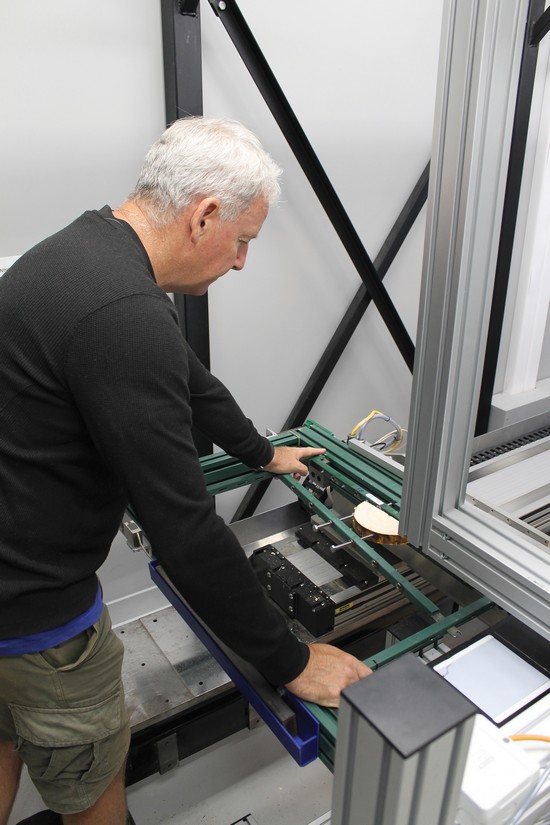Quick and efficient wood quality testing

Versatile plantation-grown radiata pine is used in a wide range of applications. To ensure we grow wood suitable for both volume- and value-based applications, we need a way to predict final wood quality.
The range of factors that cause variation in the type, number, size, shape, physical structure and chemical composition of the wood elements means this is not easy. However, Scion has been developing an automated system to efficiently analyse a range of attributes that affect wood quality.
The DiscBot robot moves samples in the form of discs or ‘slices’ of trees, cut from the log ends of felled trees, through a range of sensors.
X-rays are used to measure wood density, which is associated with high lumber strength and stiffness.
A near infrared camera is used to detect the different light absorbing qualities of lignin, cellulose and other chemicals in the wood, which can provide an estimate of pulp or energy yield, for example.
Ultrasound is used to measure the speed that soundwaves travel through the wood and is used as an indication of wood stiffness.
The distortion of visible light (RGB or red, green and blue) is used to measure wood grain angle. Grain angle can significantly affect wood strength and performance with as little as a 15-degree deviation causing a 50 percent strength loss.
Wood quality scientist John Lee says, “the DiscBot can test multiple discs quickly and efficiently. If we have a series of discs taken from the base to the tip of a stem, we can get a picture of the quality of wood that’s been laid down throughout the whole tree and how that varies.”
Why test?
Testing wood from trees at the end of a rotation provides essential information for both forest managers and researchers. Running a full suite of tests on trial trees with known genetics, silviculture and the environment provides a wealth of data that can show how interventions have affected wood quality, and how returns have been improved and what might be improved in the future.
Assessing wood properties post-harvest is also important for segregating wood prior to processing. For example, structural timber needs to be stiff. Ensuring the right wood goes to the right place will bring about savings in terms of reduction in wastage of wood and reduced manufacturing costs.
The DiscBot is currently busy carrying out work for local forestry companies who are interested in ensuring their trees will meet product specifications at harvest. In particular, they want to know if rotation lengths could be shortened without affecting wood quality and to make sure they are sending the most suitable logs to sawmills and pulp mills.
New capability
A new capability under development is the ability to assess wood quality of standing trees using 12 mm bark to pith cores. This means trees with good genes for wood density and stiffness can be identified early in a rotation and the information can be fed back into breeding programmes, speeding up the tree improvement process. Currently, the density, chemical composition and an RGB image of the cores are possible. Further work is needed to be able to assess the stiffness and grain angle of core samples.
The wood qualities of other species such as Eucalyptus is also of interest. If eucalypts with as little as one percent extra cellulose could be identified it could be worth millions of dollars to the wood pulping industry.
